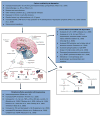Neuroimmune mechanisms of cytokine-induced depression: current theories and novel treatment strategies
- PMID: 19944762
- PMCID: PMC2995293
- DOI: 10.1016/j.nbd.2009.11.015
Neuroimmune mechanisms of cytokine-induced depression: current theories and novel treatment strategies
Abstract
The relationships between immune and neural function are an increasingly important area of study for neuropsychiatric disorders, in particular depression. This is exemplified by the growing number of publications on cytokines and depression during the last 10 years, as compared to earlier decades. This review summarizes the current theories and novel treatment strategies for depression, with a focus on cytokine-induced depression. Neuroimmune mechanisms are now viewed as central to the development of depressive symptoms and emerging evidence is beginning to identify the neural circuits involved in cytokine-induced depression. The current diagnostic categories for depression, as defined by the Diagnostic and Statistical Manual of Mental Disorders, however, are not etiologically or biologically derived, and it has been proposed that "depression", likely reflects multiple pathogeneses leading to varying symptom constellations. As we move toward a better biological understanding of depression-related symptom constellations or syndromes, the term "depression" may prove inadequately broad, and an integration of interdisciplinary literatures will increase in importance. Future research should aim to characterize these depression-related symptom constellations or syndromes better with the goal of optimizing treatment strategies.
Published by Elsevier Inc.
Figures


Similar articles
-
[Brain-immune interactions and implications in psychiatric disorders].Braz J Psychiatry. 2007 May;29 Suppl 1:S27-32. doi: 10.1590/s1516-44462007000500006. Braz J Psychiatry. 2007. PMID: 17546344 Review. Portuguese.
-
Treatment of cytokine-induced depression.Brain Behav Immun. 2002 Oct;16(5):575-80. doi: 10.1016/s0889-1591(02)00007-7. Brain Behav Immun. 2002. PMID: 12401471 Review.
-
Acute hypoxia, diabetes, and neuroimmune dysregulation: converging mechanisms in the brain.Neuroscientist. 2008 Jun;14(3):235-9. doi: 10.1177/1073858407309544. Epub 2007 Nov 13. Neuroscientist. 2008. PMID: 18000066 Review.
-
Response to immunotherapy in a 20-month-old boy with anti-NMDA receptor encephalitis.Neurology. 2010 May 11;74(19):1550-1. doi: 10.1212/WNL.0b013e3181dd41a1. Neurology. 2010. PMID: 20458074 Free PMC article. No abstract available.
-
Cytokines, stress and depressive illness: brain-immune interactions.Ann Med. 2003;35(1):2-11. doi: 10.1080/07853890310004075. Ann Med. 2003. PMID: 12693607 Review.
Cited by
-
SARS-CoV-2 mediated neuroinflammation and the impact of COVID-19 in neurological disorders.Cytokine Growth Factor Rev. 2021 Apr;58:1-15. doi: 10.1016/j.cytogfr.2021.02.002. Epub 2021 Feb 19. Cytokine Growth Factor Rev. 2021. PMID: 33674185 Free PMC article. Review.
-
PsychoBehavioroimmunology: Connecting the Behavioral Immune System to Its Physiological Foundations.Front Psychol. 2019 Feb 7;10:200. doi: 10.3389/fpsyg.2019.00200. eCollection 2019. Front Psychol. 2019. PMID: 30804853 Free PMC article.
-
Repeated Systemic Treatment with Rapamycin Affects Behavior and Amygdala Protein Expression in Rats.Int J Neuropsychopharmacol. 2018 Jun 1;21(6):592-602. doi: 10.1093/ijnp/pyy017. Int J Neuropsychopharmacol. 2018. PMID: 29462337 Free PMC article.
-
Peripheral anti-inflammatory effects explain the ginsenosides paradox between poor brain distribution and anti-depression efficacy.J Neuroinflammation. 2011 Aug 16;8:100. doi: 10.1186/1742-2094-8-100. J Neuroinflammation. 2011. PMID: 21843370 Free PMC article.
-
Differential activation of endocrine-immune networks by arthritis challenge: Insights from colony-specific responses.Sci Rep. 2017 Apr 6;7(1):698. doi: 10.1038/s41598-017-00652-4. Sci Rep. 2017. PMID: 28386080 Free PMC article.
References
-
- Aguilera M, Arias B, Wichers M, Barrantes-Vidal N, Moya J, Villa H, van Os J, Ibáñez MI, Ruipérez MA, Ortet G, Fañanás L. Early adversity and 5-HTT/BDNF genes: new evidence of gene–environment interactions on depressive symptoms in a general population. Psychol Med. 2009;39:1425–1432. - PubMed
-
- Akhondzadeh S, Jafari S, Raisi F, Nasehi AA, Ghoreishi A, Salehi B, Mohebbi-Rasa S, Raznahan M, Kamalipour A. Clinical trial of adjunctive celecoxib treatment in patients with major depression: a double blind and placebo controlled trial. Depress Anxiety. 2009;26(7):607–611. - PubMed
-
- Anisman H, Kokkinidis L, Borowski T, Merali Z. Differential effects of interleukin (IL)-1beta, IL-2 and IL-6 on responding for rewarding lateral hypothalamic stimulation. Brain Res. 1998;779:177–187. - PubMed
-
- Anisman H, Poulter MO, Gandhi R, Merali Z, Hayley S. Interferon-alpha effects are exaggerated when administered on a psychosocial stressor backdrop: cytokine, corticosterone and brain monoamine variations. J Neuroimmunol. 2007a;186:45–53. - PubMed
-
- Anisman H, Prakash P, Merali Z, Poulter MO. Corticotropin releasing hormone receptor alterations elicited by acute and chronic unpredictable stressor challenges in stressor-susceptible and resilient strains of mice. Behav Brain Res. 2007b;181:180–190. - PubMed
Publication types
MeSH terms
Substances
Grants and funding
LinkOut - more resources
Full Text Sources
Medical
Research Materials

